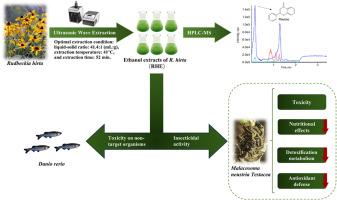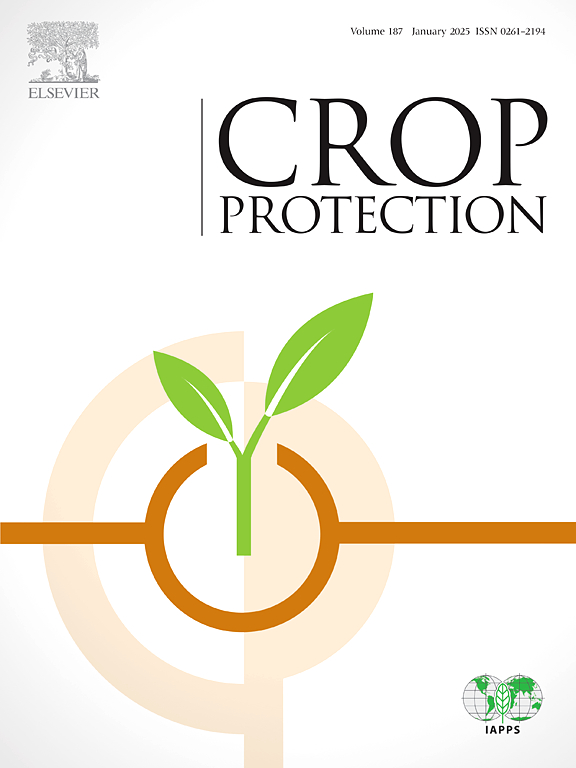Rudbeckia hirta 乙醇提取物的杀虫活性:对漆蛾(Malacosoma neustria testacea)的功效及对非目标生物的影响
IF 2.5
2区 农林科学
Q1 AGRONOMY
引用次数: 0
摘要
Rudbeckia hirta 的杀虫特性已得到公认,但仍未得到充分探索。本研究旨在优化萃取条件,分析 R. hirta(RHE)乙醇提取物的化学成分,评估 RHE 对 Malacosoma neustria testacea 幼虫的杀虫活性,并评估其对非目标水生生物的安全性。研究确定了 RHE 的最佳萃取参数:液固比为 41.4:1(mL:g),萃取温度为 41 °C,萃取时间为 52 分钟,实际萃取率为 30.27 ± 0.16%。化学分析确定了 RHE 中的 22 种化合物,其中黄酮类化合物占大多数,达 75.47%。生物测定表明,RHE 对睾丸鞘氨醇幼虫具有明显的毒性,处理后 72 小时的半致死浓度为 6.44 ± 0.14 mg/mL。RHE 还明显抑制幼虫的摄食、消化和营养吸收。此外,在暴露于 RHE 的情况下,幼虫体内的解毒和抗氧化酶活性在处理后 72 小时内明显受到抑制。安全评估表明,RHE 对丹利欧没有毒性。这些研究结果表明,RHE 可以作为化学杀虫剂的天然替代品,为管理农林系统中的蛾类害虫提供了一种可持续的方法。本文章由计算机程序翻译,如有差异,请以英文原文为准。

Insecticidal activity of the ethanol extracts from Rudbeckia hirta: Efficacy on Lackey moth (Malacosoma neustria testacea) and impact on non-target organisms
The insecticidal properties of Rudbeckia hirta have been acknowledged, yet they remain underexplored. This study aimed to optimize the extraction conditions, analyze the chemical constituents of ethanol extracts from R. hirta (RHE), assess the insecticidal activity of RHE against Malacosoma neustria testacea larvae, and evaluate its safety for non-target aquatic organisms. The optimal extraction parameters for RHE were determined to be a liquid-solid ratio of 41.4:1 (mL:g), an extraction temperature of 41 °C, and an extraction time of 52 min, resulting in an actual extraction rate of 30.27 ± 0.16%. Chemical analysis identified 22 compounds within RHE, with flavonoids comprising the majority at 75.47%. Bioassays suggested that RHE exhibited significant toxicity against M. neustria testacea larvae, with an LC50 value of 6.44 ± 0.14 mg/mL at 72 h post-treatment. RHE also markedly inhibited larval feeding, digestion, and nutrient absorption. Furthermore, under RHE exposure, detoxification and antioxidant enzyme activities in the larvae were significantly suppressed within 72 h of treatment. Safety assessments indicated that RHE exhibited no toxicity to Danio rerio. These findings suggest that RHE could serve as a natural alternative to chemical pesticides, offering a sustainable approach to managing moth pests in agroforestry systems.
求助全文
通过发布文献求助,成功后即可免费获取论文全文。
去求助
来源期刊

Crop Protection
农林科学-农艺学
CiteScore
6.10
自引率
3.60%
发文量
200
审稿时长
29 days
期刊介绍:
The Editors of Crop Protection especially welcome papers describing an interdisciplinary approach showing how different control strategies can be integrated into practical pest management programs, covering high and low input agricultural systems worldwide. Crop Protection particularly emphasizes the practical aspects of control in the field and for protected crops, and includes work which may lead in the near future to more effective control. The journal does not duplicate the many existing excellent biological science journals, which deal mainly with the more fundamental aspects of plant pathology, applied zoology and weed science. Crop Protection covers all practical aspects of pest, disease and weed control, including the following topics:
-Abiotic damage-
Agronomic control methods-
Assessment of pest and disease damage-
Molecular methods for the detection and assessment of pests and diseases-
Biological control-
Biorational pesticides-
Control of animal pests of world crops-
Control of diseases of crop plants caused by microorganisms-
Control of weeds and integrated management-
Economic considerations-
Effects of plant growth regulators-
Environmental benefits of reduced pesticide use-
Environmental effects of pesticides-
Epidemiology of pests and diseases in relation to control-
GM Crops, and genetic engineering applications-
Importance and control of postharvest crop losses-
Integrated control-
Interrelationships and compatibility among different control strategies-
Invasive species as they relate to implications for crop protection-
Pesticide application methods-
Pest management-
Phytobiomes for pest and disease control-
Resistance management-
Sampling and monitoring schemes for diseases, nematodes, pests and weeds.
 求助内容:
求助内容: 应助结果提醒方式:
应助结果提醒方式:


